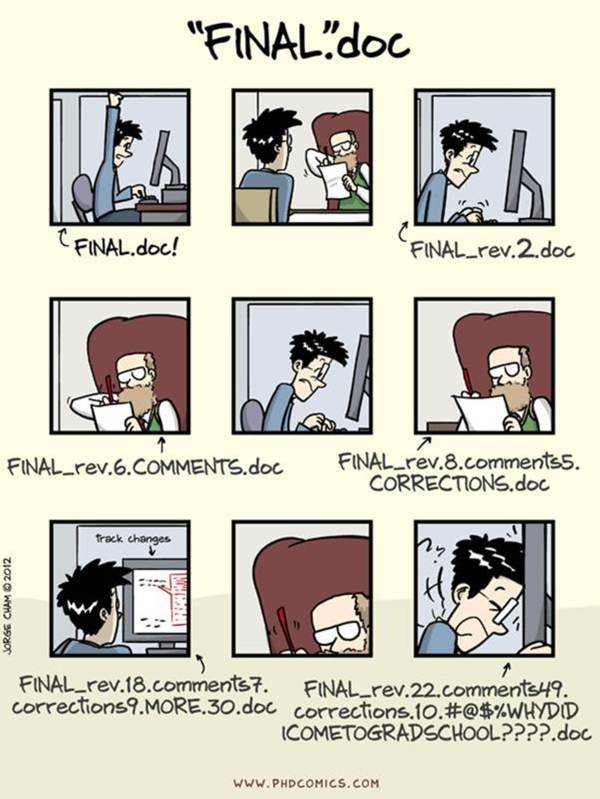Image from http://www.phdcomics.com
Phew! You’ve done it! You’ve just finished writing your first draft and sent it to all your supervisors. Now what? I was actually really surprised by just how long it took me between finishing my first draft, and submitting it to the examiners.
1) Keep feedback expectations realistic
After several years of working together with your supervisors, most graduate students have a good idea about each of their supervisor’s styles. Some supervisors can issue vague instructions, others give advice down to the smallest detail, and still others will never give any advice at all. Feedback will come in all forms (see my post on February 22) but try and work with what you’re given. Generally, your supervisor will want to help you produce the best thesis possible, because your performance reflects back on them.
When sending the supervisors draft material, set deadlines for when you want to review it with them. Just as in my last post I recommended setting deadlines for your writing with your supervisors, the same is now reversed for setting deadlines for your supervisors feedback during a meeting with you. Make sure the deadlines you give them are reasonable, but do set a meeting time and turn up, regardless of how much you hear back from them in the meantime. If they repeatedly miss deadlines, assess the situation, and either apply more pressure or look for feedback from a different source.
2) Keep turnaround time minimal
Your supervisors are going out of their way to make sure that not only did your experiments go well, but that your entire PhD does, including the thesis. An elegant PhD project with good results is only as good as the thesis your examiner reads. Because your supervisor is taking their time out to help with the thesis, it is important that they never have to edit the same thing twice. This is particularly true if you have several supervisors reading your thesis at the same time. It’s only fair to them, that you are not wasting their time, by having them correct something you’ve already corrected based on feedback from a different supervisor. Incorporate their changes, and distribute the latest draft as soon as possible. Obviously, rename the file so they know it’s a new draft.
3) The Tedious Details: A Checklist
- Check the margin requirements set by the university.
- Check the line spacing.
- Check the word count.
- Check the font and formatting (particularly important for Microsoft in order to generate an automatic Table of Contents).
- Set the thesis language and use spell-check. As a scientist I confess that I often ignore the Microsoft spell-check, because a lot of the time it doesn’t know scientific terms. Go through and use it anyway, because it will catch common words that you’ve misspelled. And teach it the scientific terms (“add to dictionary”) – but make sure that you teach it the correct way to spell the word, otherwise it will forevermore be misspelled in your thesis.
- Check your spacing. I spent 4 hours one very tedious afternoon going through all 200 pages of my thesis and checking there were two spaces between all the sentences.
- Clarify any sentence that starts with the word “this”.
- Find synonyms for every time you’ve used the word “important” – your thesis is not that important.
- Find synonyms for, or simply remove all references to something “interesting” – your thesis is not that interesting.
- Take a deep breath and count to ten.
4) Take care of the paperwork
Several weeks in advance of when you think you’re going to submit, check the paperwork requirements set by the University. You might find, as I found at Oxford, that some paperwork is due to be submitted 6 weeks prior to submitting the thesis and that this can delay the process if you haven’t submitted it with enough time. Also, check any paperwork that needs to be submitted at the same time as the thesis. Also, check for any further impediments to your thesis being accepted (as per my post on April 4th), and remove any obstacles.
5) Assess the printing, binding, and submitting situation
One of my flat-mates who recently submitted her thesis warned me that the process on the day of submission takes longer than you might think it should. That is certainly true. One of the things to decide is where to print the thesis. Crucially for this is the decision of how many, if any, pages should be in color and also the cost of printing vs. photocopying. Then, figure out how the thesis is going to get bound (again, check the university regulations), and if using a company to professionally bind the thesis, find out their opening hours. Most importantly, figure out the opening hours of the university office that is going to be accepting the bound thesis. Buy any envelopes etc. needed.
6) The final day
If you have not yet done so, reread the entirety of the thesis to check for any last-minute corrections. Make sure to do this while fully awake. Update the bibliography. Update the table of contents. Convert the document to a PDF. Print using the PDF. Partway through the printing, check the printed pages to ensure that your printer has not run out of ink. I printed about 50 pages that had to be reprinted from a different printer because the printer had run out of ink and the quality was unacceptable. Hand the thesis to the binder then wander around the city in purgatory until you can return to pick up your finished product. Take the thesis, with any necessary paperwork, to the appropriate university office and submit it.
7) Book a holiday
At some point during the time between writing the first draft and submitting the thesis, book a holiday to start a few days after you’ve submitted. By then you’ll have recovered from both the exhaustion of the last few days, and from the partying after submitting. Go somewhere different and relax. If you’re lucky, get engaged.





